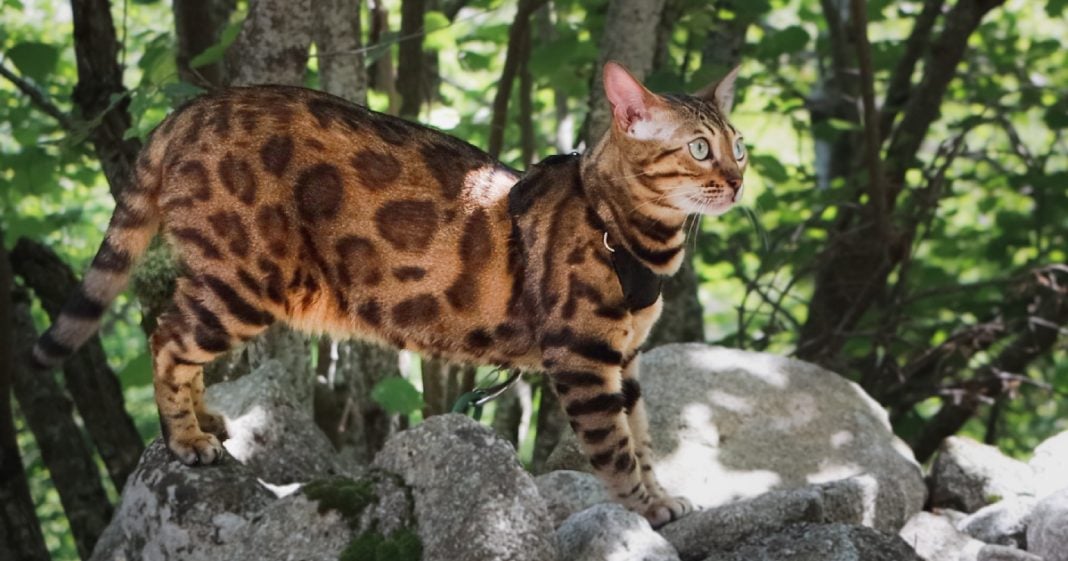Teaching your Bengal cat to walk on a harness may sound tricky, but it’s a relatively simple process that requires just a little patience and time. Bengal cats tend to be intelligent creatures with boundless energy and a desire to learn new things, so don’t be surprised if your kitty takes to strapping in and getting out for adventure right away! Especially if you’ve got a feline who craves adventure like Mia the Bengal cat.
From the moment cat dad Albert met Mia, he knew she was a high-energy cat who needed more than indoor playtime to burn all her excess energy. So, as a paw parent devoted to helping his Bengal cat thrive, Albert taught Mia to wear a harness so they could both enjoy the outdoor life. And after only a few training sessions, Mia was ready to prowl the world, allowing Albert to take her places he never thought possible.
And if you and your Bengal are an adventurous pair like Albert and Mia, it won’t be long before you’ve taught your cat how to walk on a harness with these easy steps! Plus, when you and your cat take it outside for some fun, you’re providing your rosette-wearing feline with a wealth of benefits to their well-being.
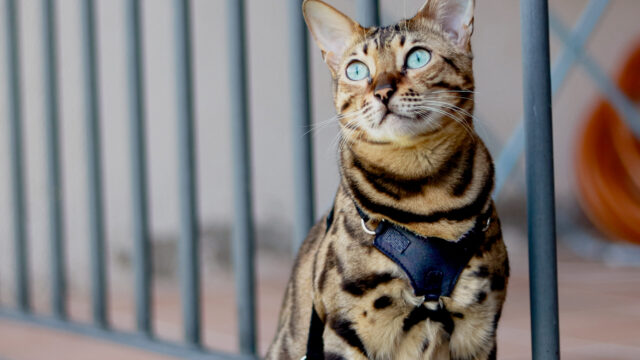
Three Reasons to Walk Your Bengal Cat
While not all cats want to put on a harness and head out for a walk, Bengal cats and their high-energy drives will often take right to it because they need and want the activity. Mia loves life on the harness, and Albert reports seeing these three benefits from teaching her to walk on a leash.
#1 – Harnessing Up Can Unleash Curiosity
When cats get a chance to explore the outdoors, their natural hunting and survival skills activate, and their curiosity comes alive. This chance to unleash the wild and primal side helps cats thrive in all aspects of their lives.
#2 – Drain Your Little Big Cat’s Energy
Cats love to explore, and going outside gives them lots of space to sniff and snoop. They’ll spend time investigating every little thing, giving their instincts and energy levels a chance to go wild. Whether they’re exploring a hole in the ground or a tree that makes a good vantage point for a cat to survey the land, your furry explorer will use every one of their senses to take it all in. Couple that with some running around, and you’ve got one worn-out kitty on your hands! And a cat who gets plenty of healthy stimulation and exercise is a happy one!
#3 – Together Time Deepens Your Bond
Not only does walking your cat on a leash provide stimulation and exercise, but it also serves to deepen the bond between you and your cat. And when you get back home after outdoor adventures, your cat will most likely be ready for a nap. And their favorite place to sleep is curled up in your arms, and snuggle time is also bonding time!
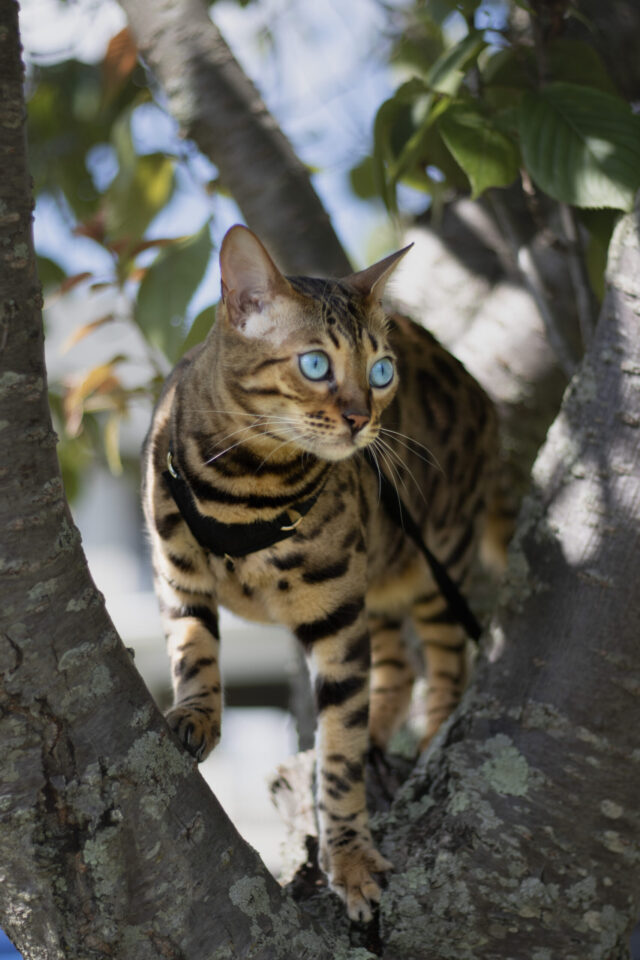
Teach Your Bengal Cat To Walk On A Harness
When teaching your Bengal to walk on a leash, stick to these four simple but essential steps:
- Choose the right harness.
- Desensitize your cat to the harness.
- Put on the harness.
- Walk your cat on a leash.
And remember, treating your cat to a tasty tidbit for a job well done is a key to success for every step of harness training!
Choose the Right Harness
When you start the search for your cat’s harness, be prepared for pages on pages of results. You’ll probably find some stand-out options right away and easily dismiss some too. But that still leaves you with hundreds of options to wade through. And while they aren’t all winners, there’s a harness out there for every cat. For help finding your kitty’s perfect option, check out What to Look for In A Harness For Your Cat.
Once you’ve decided what harness you need for your cat, getting the right size is crucial. A harness that’s too big makes it easier for your cat to escape, while one that’s too small can cause discomfort. And a cat who finds a harness uncomfortable is likely to plop on their side and refuse to move. And that’s no fun for anyone! To avoid a misfit, study the manufacturer’s recommendations on size and measure your cat before buying. The ideal fit allows two to three fingers to slip between the harness and your cat’s body.
If you’re still unsure which harness to try, consider the OutdoorBengal Escape-Proof Cat Harness. It’s lightweight and makes escape nearly impossible.
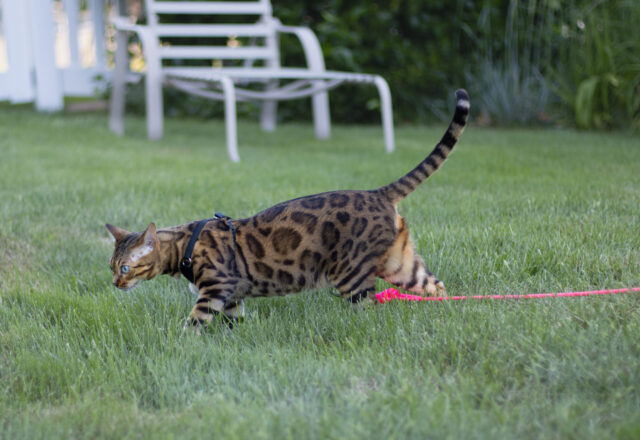
Desensitize Your Cat to the Harness
You know how cats can be; when you bring them something new, they aren’t always thrilled recipients. Unless it’s catnip. Then you’ll see some immediate gratitude from your feline! But otherwise, cats usually take a while to get comfortable around new things, and this will include their harness too.
To desensitize your cat to the harness, place the harness in areas where your cat hangs out most and let them soak the harness with their scent. Once the harness smells a little more like your cat and a little less like a factory and dyes, the easier it will be to get your cat used to wearing it. When you see your cat checking out the harness, praise them for their boldness and hand them a treat! Repeat this until your cat thinks the harness’s presence is no big deal. Just remember to take your time and take things slow. This is supposed to be the beginning of lots of fun for you and your cat, and you don’t want to spoil it by rushing interactions with the new and unfamiliar harness.
Put the Harness on Your Cat
Now, the moment of truth is upon you. It’s time to put the harness on your cat! The easiest way to put a harness on your cat is by teaching them to sit and stay. Want to teach your cat to sit? Outdoor Bengal offers this excellent video tutorial on how to train your cat to sit and stay.
If your cat doesn’t know how to sit and stay, you can also put the harness on by securing your kitty’s rump between your elbow and body, leaving both free hands to strap your cat into the harness. In the video below, Albert and Mia illustrate how to put a harness on your cat.
You’ve done it! Your cat is in their new harness. One of two things will likely happen now…
1) Your cat doesn’t mind the harness and starts eating and playing right away while wearing it.
2) Your cat hates the harness and doesn’t move or plops on the floor.
If your cat doesn’t mind wearing the harness, congratulations! You’ve got a cat that’s ready to walk on a leash! But if your kitty is less than thrilled about their new accessory, that’s okay too. It just means more practice is needed. Repeat the trying-on process and reward generously until your cat doesn’t fuss about wearing the harness. This process might take up to a few weeks, so don’t give up. The reward is well worth the work for both you and your cat.
Walk Your Cat on a Leash
Once your cat is comfortable wearing the harness, adding the leash shouldn’t be hard. Start indoors to acclimate your cat to being guided via the leash. Once the two of you have strolling about the house mastered, venture outdoors to a quiet spot free of dogs and unfamiliar people. As your cat gets more and more accustomed to the leash life, you can start braving more populated areas. And soon, you and your feline BFF will be trekking everywhere!
Habituation happens when experience beats expectations. If your cat doesn’t like something but is slowly and consistently faced with that situation, and the outcome is a positive experience, their fear of that event will eventually diminish. However, the line between advancing and creating trauma is very fine. If your cat has a bad experience, weeks of progress can be lost in just one day. To keep things positive, sessions should be kept short and sweet.
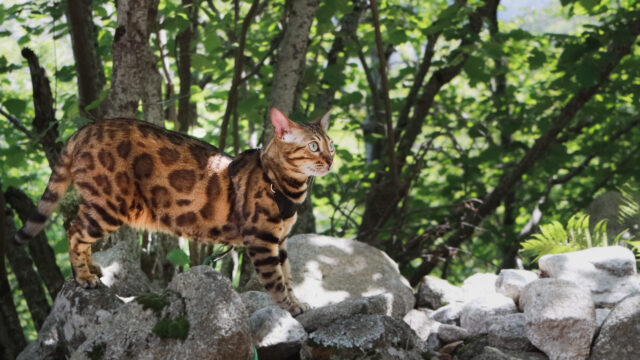
Now, are you and your cat ready for some adventure? Then get your cat an OutdoorBengal Escape-Proof Cat Harness and get outside. And while you’re roaming, you might just find Albert and Mia out there too!

